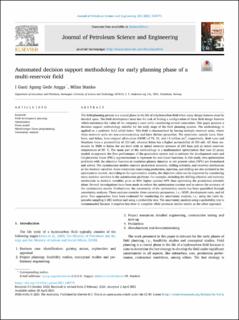| dc.contributor.author | Angga, I Gusti Agung Gede | |
| dc.contributor.author | Stanko Wolf, Milan Edvard | |
| dc.date.accessioned | 2022-03-08T09:16:03Z | |
| dc.date.available | 2022-03-08T09:16:03Z | |
| dc.date.created | 2021-04-26T00:06:33Z | |
| dc.date.issued | 2021 | |
| dc.identifier.issn | 0920-4105 | |
| dc.identifier.uri | https://hdl.handle.net/11250/2983674 | |
| dc.description.abstract | The field planning process is a crucial phase in the life of a hydrocarbon field when many design features must be decided upon. The field development team has the task of finding a configuration of these field design features which maximizes the value of the company's asset while considering several constraints. This paper presents a decision support methodology suitable for the early stage of the field planning process. The methodology is applied on a synthetic field called Safari. This field is characterized by having multiple reservoir units, where these reservoir units are non-communicating and have distinct properties. The reservoirs, namely Løve, Nesehorn, and Sebra, have original oil-in-place (OOIP) of 75, 55, and 13 million sm3, respectively. Both Løve and Nesehorn have a permeability of 250 mD, whereas Sebra has a higher permeability of 450 mD. All these reservoirs lie 2500 m below the sea level with an initial reservoir pressure of 280 bara and an initial reservoir temperature of 80 °C. The main part of the methodology is a mathematical optimization that uses (i) proxy models to represent the flow performance of the production system and to estimate the development costs and (ii) piecewise linear (PWL) approximations to represent the non-linear functions. In this study, two optimization problems with the objective function to maximize plateau duration or net present value (NPV) are formulated and solved. The optimization models consider production schedule, drilling schedule, and recovery mechanism as the decision variables. Some constraints concerning production, injection, and drilling are also included in the optimization models. According to the optimization results, the objective value can be improved by considering more decision variables in the optimization problems. For example, including the drilling schedule and recovery mechanism as decision variables gives us 85% higher optimal NPV than optimizing the production schedule alone. Several investigations have been made to reduce the optimization runtime and to ensure the accuracy of the optimization results. Furthermore, the uncertainty of the optimization results has been quantified through uncertainty analyses. These analyses consider three uncertain parameters, i.e., OOIP, development costs, and oil price. Two approaches have been evaluated for conducting the uncertainty analysis, i.e., using the Latin hypercube sampling (LHS) method and using a probability tree. The uncertainty analysis using a probability tree is recommended because it requires less time to complete while produces similar results as the other approach. | en_US |
| dc.language.iso | eng | en_US |
| dc.publisher | Elsevier | en_US |
| dc.rights | Navngivelse 4.0 Internasjonal | * |
| dc.rights.uri | http://creativecommons.org/licenses/by/4.0/deed.no | * |
| dc.subject | Matematisk optimering | en_US |
| dc.subject | Mathematical optimization | en_US |
| dc.subject | Optimering | en_US |
| dc.subject | Optimization | en_US |
| dc.subject | Usikkerhetsanalyse | en_US |
| dc.subject | Uncertainty analysis | en_US |
| dc.title | Automated decision support methodology for early planning phase of a multi-reservoir field | en_US |
| dc.type | Peer reviewed | en_US |
| dc.type | Journal article | en_US |
| dc.description.version | publishedVersion | en_US |
| dc.subject.nsi | VDP::Petroleumsteknologi: 512 | en_US |
| dc.subject.nsi | VDP::Petroleum engineering: 512 | en_US |
| dc.source.volume | 205 | en_US |
| dc.source.journal | Journal of Petroleum Science and Engineering | en_US |
| dc.identifier.doi | 10.1016/j.petrol.2021.108773 | |
| dc.identifier.cristin | 1906312 | |
| cristin.ispublished | true | |
| cristin.fulltext | original | |
| cristin.qualitycode | 2 | |

